Complete Syllabus: Computer Science & Engineering Course Semesters 3-8
VerifiedAdded on 2023/06/12
|49
|22687
|207
Homework Assignment
AI Summary
This document presents a detailed syllabus for a Bachelor of Technology (B. Tech) program in Computer Science & Engineering, covering the third through eighth semesters. It includes course codes, subject names, lecture (L), tutorial (T), and practical (P) hours per week, and credit allocations for each subject. The syllabus outlines both theoretical subjects like Mathematics, Data Structures & Algorithms, Circuit Theory & Networks, Computer Organization, Digital Electronics & Logic Design, Operating Systems, Database Management Systems, and Computer Networks, as well as corresponding practical lab sessions. Additionally, it includes details on elective courses, industrial training, and project work, providing a comprehensive overview of the curriculum's structure and content for each semester. Desklib provides solved assignments and past papers for students.
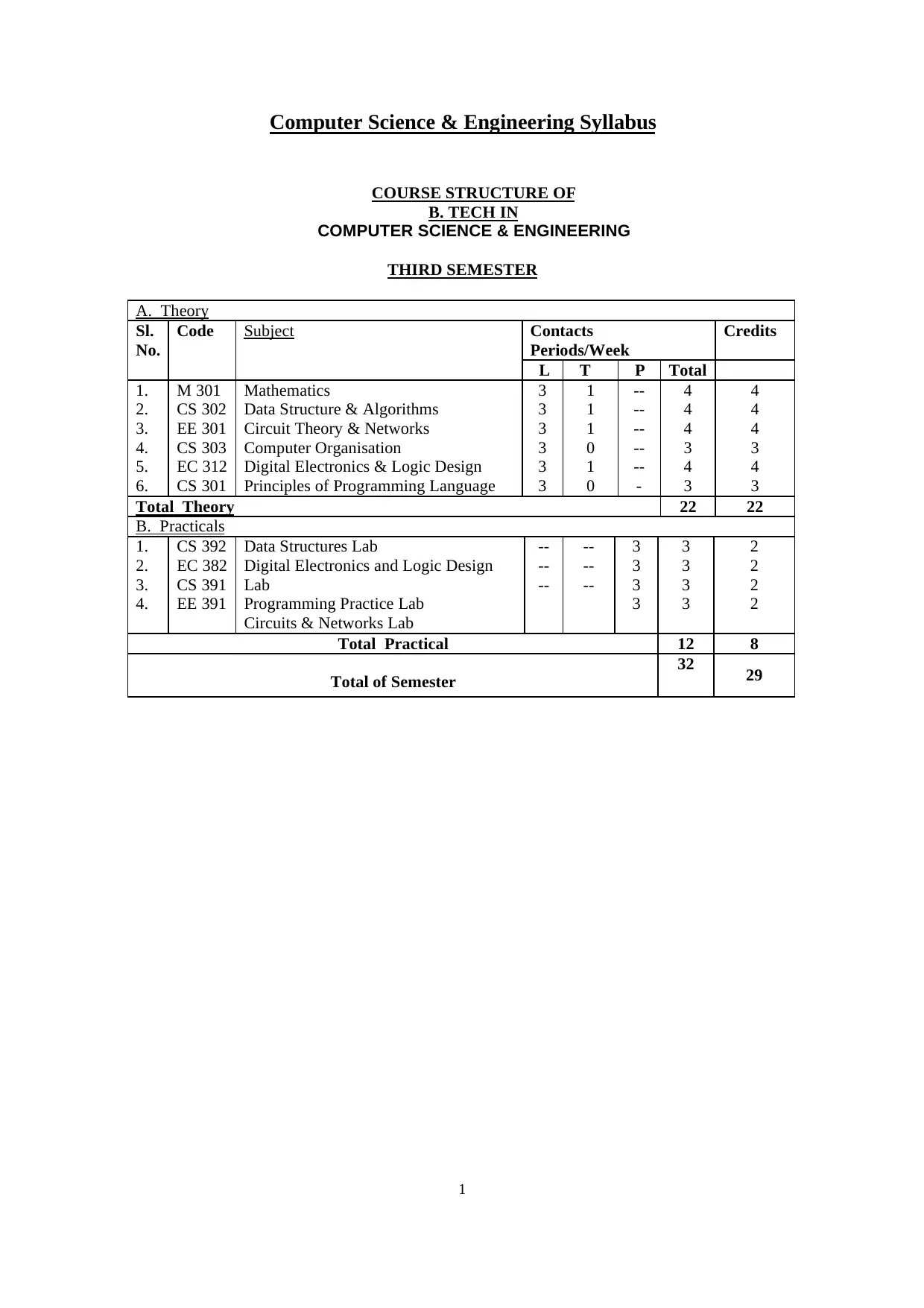
Computer Science & Engineering Syllabus
1
COURSE STRUCTURE OF
B. TECH IN
COMPUTER SCIENCE & ENGINEERING
THIRD SEMESTER
A. Theory
Sl.
No.
Code Subject Contacts
Periods/Week
Credits
L T P Total
1.
2.
3.
4.
5.
6.
M 301
CS 302
EE 301
CS 303
EC 312
CS 301
Mathematics
Data Structure & Algorithms
Circuit Theory & Networks
Computer Organisation
Digital Electronics & Logic Design
Principles of Programming Language
3
3
3
3
3
3
1
1
1
0
1
0
--
--
--
--
--
-
4
4
4
3
4
3
4
4
4
3
4
3
Total Theory 22 22
B. Practicals
1.
2.
3.
4.
CS 392
EC 382
CS 391
EE 391
Data Structures Lab
Digital Electronics and Logic Design
Lab
Programming Practice Lab
Circuits & Networks Lab
--
--
--
--
--
--
3
3
3
3
3
3
3
3
2
2
2
2
Total Practical 12 8
Total of Semester
32 29
1
COURSE STRUCTURE OF
B. TECH IN
COMPUTER SCIENCE & ENGINEERING
THIRD SEMESTER
A. Theory
Sl.
No.
Code Subject Contacts
Periods/Week
Credits
L T P Total
1.
2.
3.
4.
5.
6.
M 301
CS 302
EE 301
CS 303
EC 312
CS 301
Mathematics
Data Structure & Algorithms
Circuit Theory & Networks
Computer Organisation
Digital Electronics & Logic Design
Principles of Programming Language
3
3
3
3
3
3
1
1
1
0
1
0
--
--
--
--
--
-
4
4
4
3
4
3
4
4
4
3
4
3
Total Theory 22 22
B. Practicals
1.
2.
3.
4.
CS 392
EC 382
CS 391
EE 391
Data Structures Lab
Digital Electronics and Logic Design
Lab
Programming Practice Lab
Circuits & Networks Lab
--
--
--
--
--
--
3
3
3
3
3
3
3
3
2
2
2
2
Total Practical 12 8
Total of Semester
32 29
Paraphrase This Document
Need a fresh take? Get an instant paraphrase of this document with our AI Paraphraser
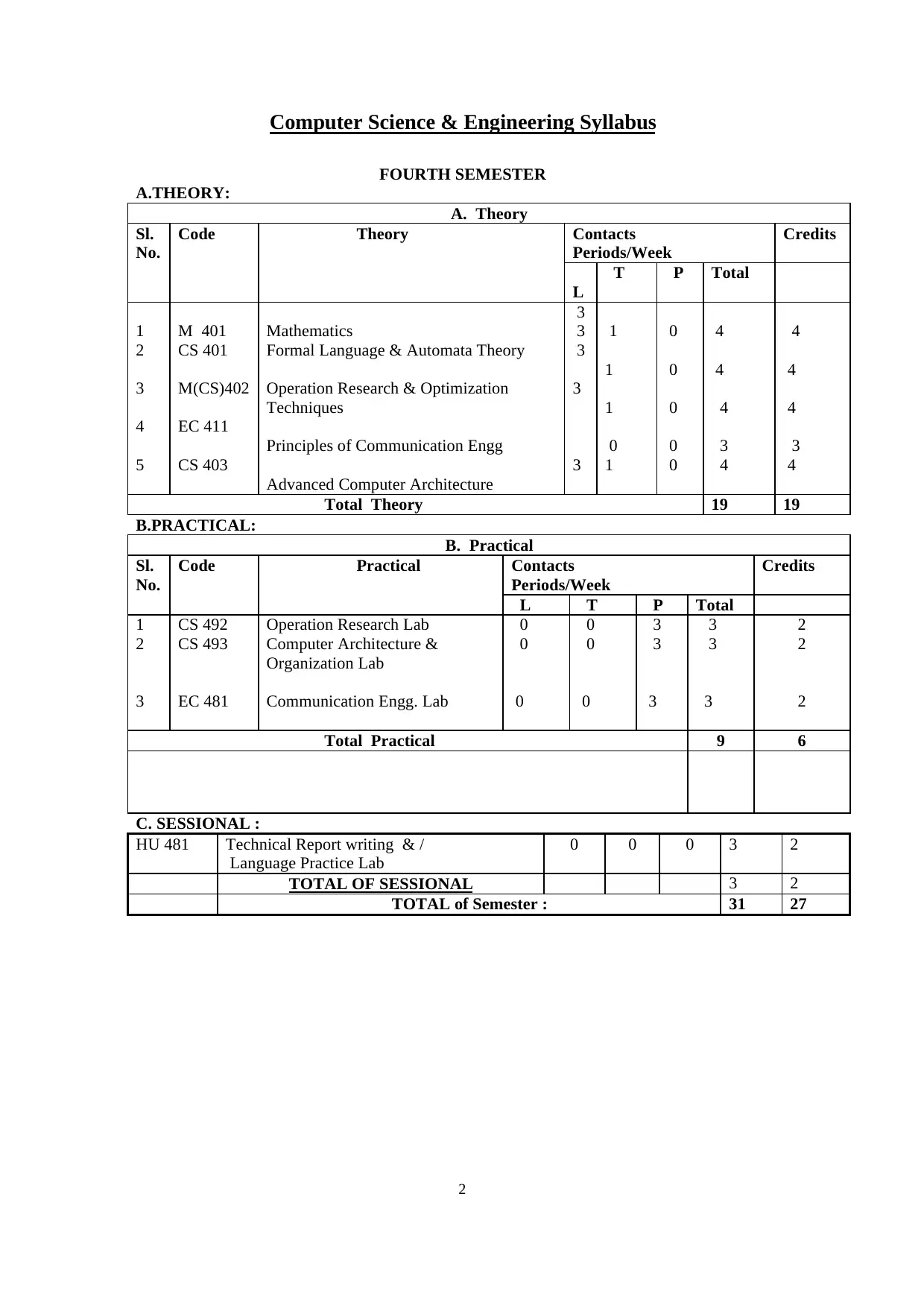
Computer Science & Engineering Syllabus
2
FOURTH SEMESTER
A.THEORY:
A. Theory
Sl.
No.
Code Theory Contacts
Periods/Week
Credits
L
T P Total
1
2
3
4
5
M 401
CS 401
M(CS)402
EC 411
CS 403
Mathematics
Formal Language & Automata Theory
Operation Research & Optimization
Techniques
Principles of Communication Engg
Advanced Computer Architecture
3
3
3
3
3
1
1
1
0
1
0
0
0
0
0
4
4
4
3
4
4
4
4
3
4
Total Theory 19 19
B.PRACTICAL:
B. Practical
Sl.
No.
Code Practical Contacts
Periods/Week
Credits
L T P Total
1
2
3
CS 492
CS 493
EC 481
Operation Research Lab
Computer Architecture &
Organization Lab
Communication Engg. Lab
0
0
0
0
0
0
3
3
3
3
3
3
2
2
2
Total Practical 9 6
C. SESSIONAL :
HU 481 Technical Report writing & /
Language Practice Lab
0 0 0 3 2
TOTAL OF SESSIONAL 3 2
TOTAL of Semester : 31 27
2
FOURTH SEMESTER
A.THEORY:
A. Theory
Sl.
No.
Code Theory Contacts
Periods/Week
Credits
L
T P Total
1
2
3
4
5
M 401
CS 401
M(CS)402
EC 411
CS 403
Mathematics
Formal Language & Automata Theory
Operation Research & Optimization
Techniques
Principles of Communication Engg
Advanced Computer Architecture
3
3
3
3
3
1
1
1
0
1
0
0
0
0
0
4
4
4
3
4
4
4
4
3
4
Total Theory 19 19
B.PRACTICAL:
B. Practical
Sl.
No.
Code Practical Contacts
Periods/Week
Credits
L T P Total
1
2
3
CS 492
CS 493
EC 481
Operation Research Lab
Computer Architecture &
Organization Lab
Communication Engg. Lab
0
0
0
0
0
0
3
3
3
3
3
3
2
2
2
Total Practical 9 6
C. SESSIONAL :
HU 481 Technical Report writing & /
Language Practice Lab
0 0 0 3 2
TOTAL OF SESSIONAL 3 2
TOTAL of Semester : 31 27
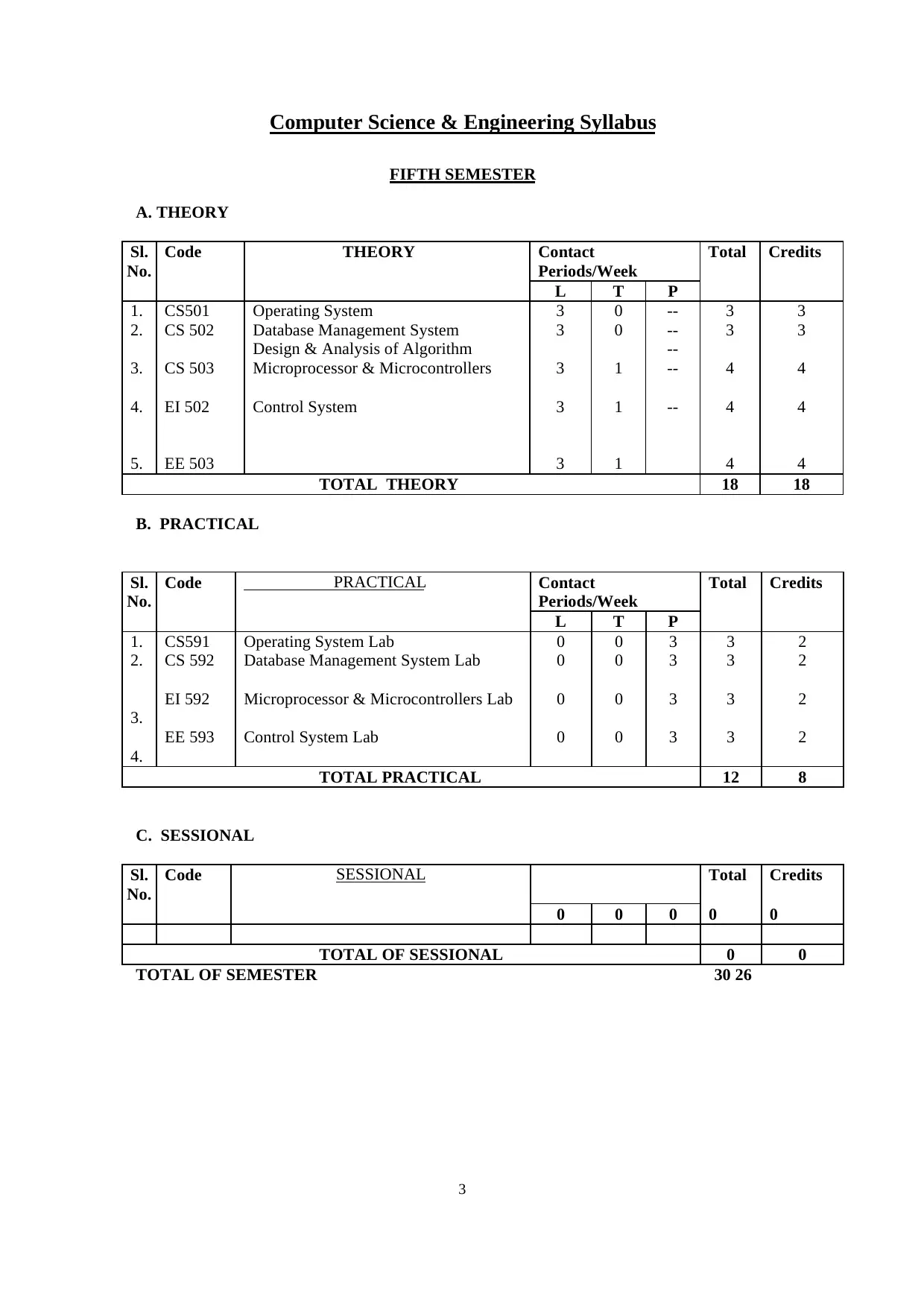
Computer Science & Engineering Syllabus
3
FIFTH SEMESTER
A. THEORY
Sl.
No.
Code THEORY Contact
Periods/Week
Total Credits
L T P
1.
2.
3.
4.
5.
CS501
CS 502
CS 503
EI 502
EE 503
Operating System
Database Management System
Design & Analysis of Algorithm
Microprocessor & Microcontrollers
Control System
3
3
3
3
3
0
0
1
1
1
--
--
--
--
--
3
3
4
4
4
3
3
4
4
4
TOTAL THEORY 18 18
B. PRACTICAL
Sl.
No.
Code PRACTICAL Contact
Periods/Week
Total Credits
L T P
1.
2.
3.
4.
CS591
CS 592
EI 592
EE 593
Operating System Lab
Database Management System Lab
Microprocessor & Microcontrollers Lab
Control System Lab
0
0
0
0
0
0
0
0
3
3
3
3
3
3
3
3
2
2
2
2
TOTAL PRACTICAL 12 8
C. SESSIONAL
Sl.
No.
Code SESSIONAL Total Credits
0 0 0 0 0
TOTAL OF SESSIONAL 0 0
TOTAL OF SEMESTER 30 26
3
FIFTH SEMESTER
A. THEORY
Sl.
No.
Code THEORY Contact
Periods/Week
Total Credits
L T P
1.
2.
3.
4.
5.
CS501
CS 502
CS 503
EI 502
EE 503
Operating System
Database Management System
Design & Analysis of Algorithm
Microprocessor & Microcontrollers
Control System
3
3
3
3
3
0
0
1
1
1
--
--
--
--
--
3
3
4
4
4
3
3
4
4
4
TOTAL THEORY 18 18
B. PRACTICAL
Sl.
No.
Code PRACTICAL Contact
Periods/Week
Total Credits
L T P
1.
2.
3.
4.
CS591
CS 592
EI 592
EE 593
Operating System Lab
Database Management System Lab
Microprocessor & Microcontrollers Lab
Control System Lab
0
0
0
0
0
0
0
0
3
3
3
3
3
3
3
3
2
2
2
2
TOTAL PRACTICAL 12 8
C. SESSIONAL
Sl.
No.
Code SESSIONAL Total Credits
0 0 0 0 0
TOTAL OF SESSIONAL 0 0
TOTAL OF SEMESTER 30 26
⊘ This is a preview!⊘
Do you want full access?
Subscribe today to unlock all pages.

Trusted by 1+ million students worldwide
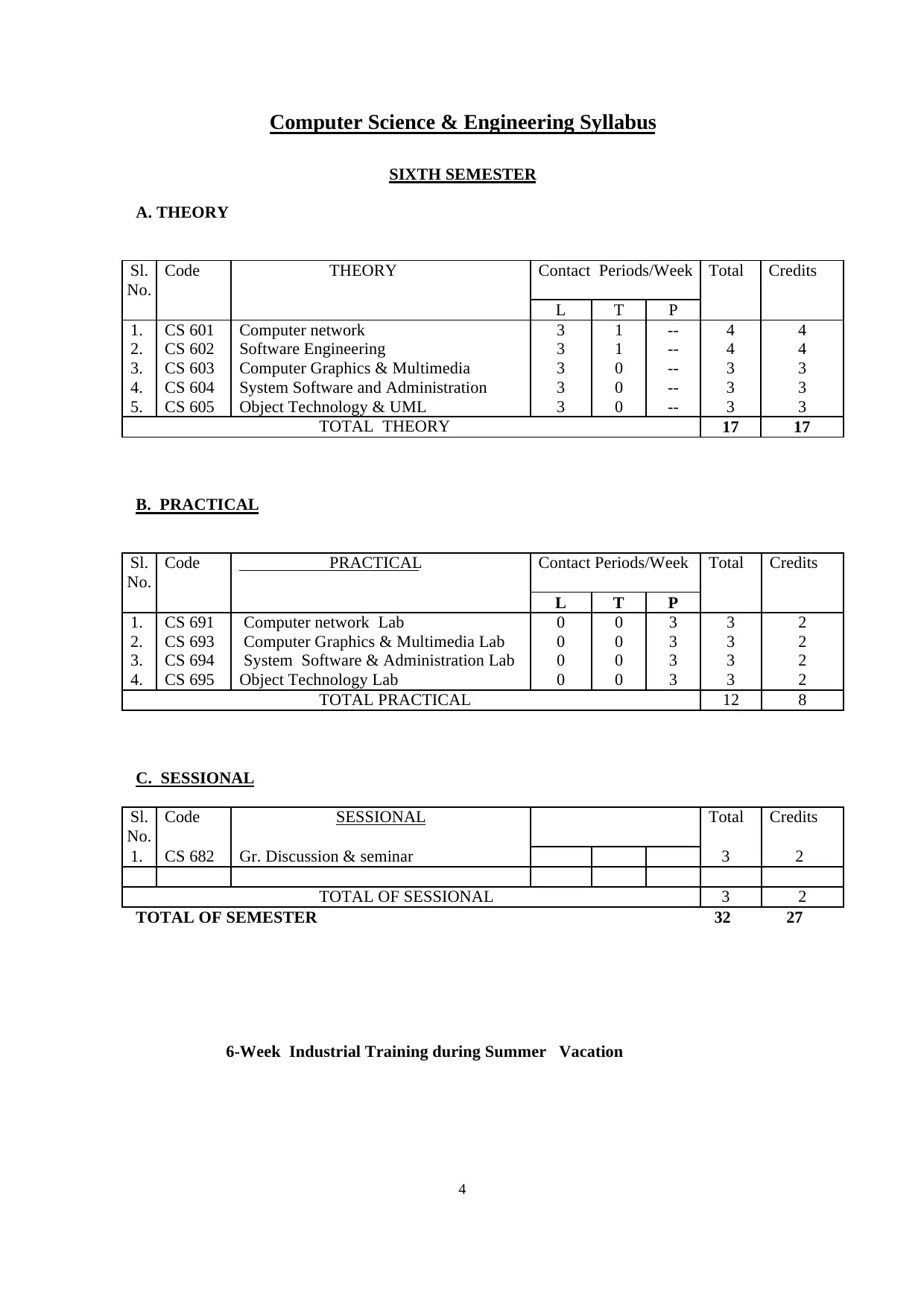
Computer Science & Engineering Syllabus
4
SIXTH SEMESTER
A. THEORY
Sl.
No.
Code THEORY Contact Periods/Week Total Credits
L T P
1.
2.
3.
4.
5.
CS 601
CS 602
CS 603
CS 604
CS 605
Computer network
Software Engineering
Computer Graphics & Multimedia
System Software and Administration
Object Technology & UML
3
3
3
3
3
1
1
0
0
0
--
--
--
--
--
4
4
3
3
3
4
4
3
3
3
TOTAL THEORY 17 17
B. PRACTICAL
Sl.
No.
Code PRACTICAL Contact Periods/Week Total Credits
L T P
1.
2.
3.
4.
CS 691
CS 693
CS 694
CS 695
Computer network Lab
Computer Graphics & Multimedia Lab
System Software & Administration Lab
Object Technology Lab
0
0
0
0
0
0
0
0
3
3
3
3
3
3
3
3
2
2
2
2
TOTAL PRACTICAL 12 8
C. SESSIONAL
Sl.
No.
Code SESSIONAL Total Credits
1. CS 682 Gr. Discussion & seminar 3 2
TOTAL OF SESSIONAL 3 2
TOTAL OF SEMESTER 32 27
6-Week Industrial Training during Summer Vacation
4
SIXTH SEMESTER
A. THEORY
Sl.
No.
Code THEORY Contact Periods/Week Total Credits
L T P
1.
2.
3.
4.
5.
CS 601
CS 602
CS 603
CS 604
CS 605
Computer network
Software Engineering
Computer Graphics & Multimedia
System Software and Administration
Object Technology & UML
3
3
3
3
3
1
1
0
0
0
--
--
--
--
--
4
4
3
3
3
4
4
3
3
3
TOTAL THEORY 17 17
B. PRACTICAL
Sl.
No.
Code PRACTICAL Contact Periods/Week Total Credits
L T P
1.
2.
3.
4.
CS 691
CS 693
CS 694
CS 695
Computer network Lab
Computer Graphics & Multimedia Lab
System Software & Administration Lab
Object Technology Lab
0
0
0
0
0
0
0
0
3
3
3
3
3
3
3
3
2
2
2
2
TOTAL PRACTICAL 12 8
C. SESSIONAL
Sl.
No.
Code SESSIONAL Total Credits
1. CS 682 Gr. Discussion & seminar 3 2
TOTAL OF SESSIONAL 3 2
TOTAL OF SEMESTER 32 27
6-Week Industrial Training during Summer Vacation
Paraphrase This Document
Need a fresh take? Get an instant paraphrase of this document with our AI Paraphraser
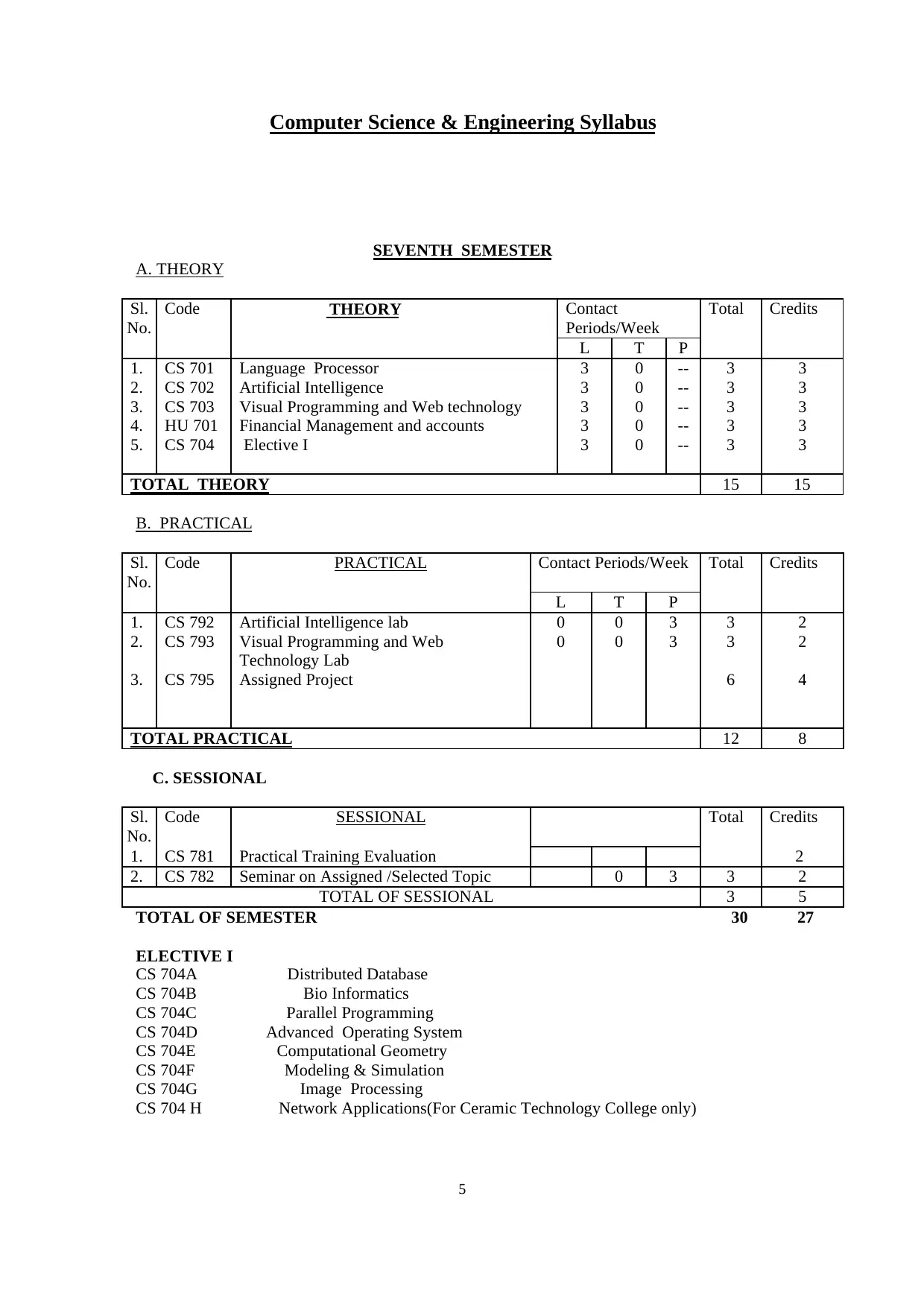
Computer Science & Engineering Syllabus
5
SEVENTH SEMESTER
A. THEORY
Sl.
No.
Code THEORY Contact
Periods/Week
Total Credits
L T P
1.
2.
3.
4.
5.
CS 701
CS 702
CS 703
HU 701
CS 704
Language Processor
Artificial Intelligence
Visual Programming and Web technology
Financial Management and accounts
Elective I
3
3
3
3
3
0
0
0
0
0
--
--
--
--
--
3
3
3
3
3
3
3
3
3
3
TOTAL THEORY 15 15
B. PRACTICAL
Sl.
No.
Code PRACTICAL Contact Periods/Week Total Credits
L T P
1.
2.
3.
CS 792
CS 793
CS 795
Artificial Intelligence lab
Visual Programming and Web
Technology Lab
Assigned Project
0
0
0
0
3
3
3
3
6
2
2
4
TOTAL PRACTICAL 12 8
C. SESSIONAL
Sl.
No.
Code SESSIONAL Total Credits
1. CS 781 Practical Training Evaluation 2
2. CS 782 Seminar on Assigned /Selected Topic 0 3 3 2
TOTAL OF SESSIONAL 3 5
TOTAL OF SEMESTER 30 27
ELECTIVE I
CS 704A Distributed Database
CS 704B Bio Informatics
CS 704C Parallel Programming
CS 704D Advanced Operating System
CS 704E Computational Geometry
CS 704F Modeling & Simulation
CS 704G Image Processing
CS 704 H Network Applications(For Ceramic Technology College only)
5
SEVENTH SEMESTER
A. THEORY
Sl.
No.
Code THEORY Contact
Periods/Week
Total Credits
L T P
1.
2.
3.
4.
5.
CS 701
CS 702
CS 703
HU 701
CS 704
Language Processor
Artificial Intelligence
Visual Programming and Web technology
Financial Management and accounts
Elective I
3
3
3
3
3
0
0
0
0
0
--
--
--
--
--
3
3
3
3
3
3
3
3
3
3
TOTAL THEORY 15 15
B. PRACTICAL
Sl.
No.
Code PRACTICAL Contact Periods/Week Total Credits
L T P
1.
2.
3.
CS 792
CS 793
CS 795
Artificial Intelligence lab
Visual Programming and Web
Technology Lab
Assigned Project
0
0
0
0
3
3
3
3
6
2
2
4
TOTAL PRACTICAL 12 8
C. SESSIONAL
Sl.
No.
Code SESSIONAL Total Credits
1. CS 781 Practical Training Evaluation 2
2. CS 782 Seminar on Assigned /Selected Topic 0 3 3 2
TOTAL OF SESSIONAL 3 5
TOTAL OF SEMESTER 30 27
ELECTIVE I
CS 704A Distributed Database
CS 704B Bio Informatics
CS 704C Parallel Programming
CS 704D Advanced Operating System
CS 704E Computational Geometry
CS 704F Modeling & Simulation
CS 704G Image Processing
CS 704 H Network Applications(For Ceramic Technology College only)
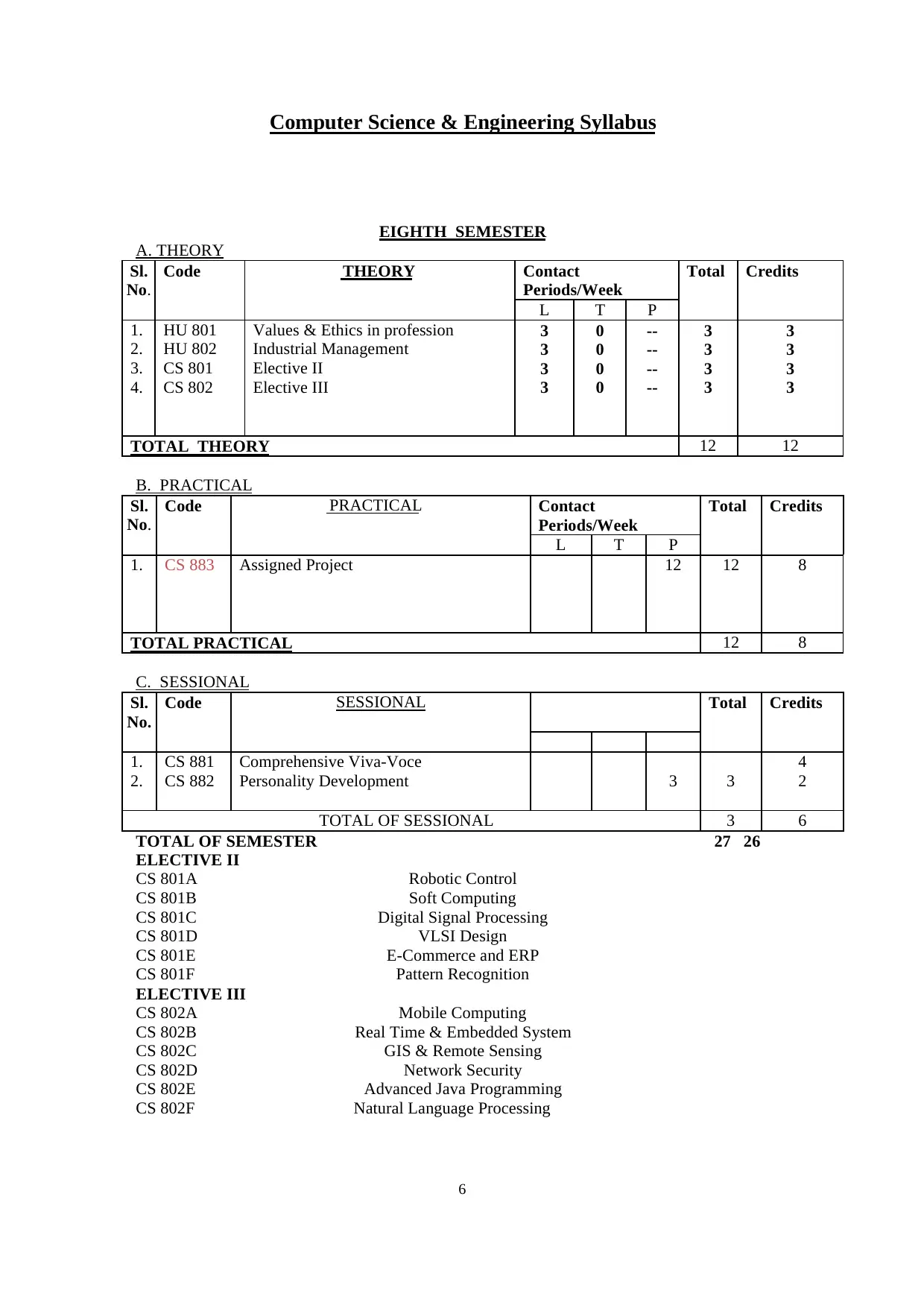
Computer Science & Engineering Syllabus
6
EIGHTH SEMESTER
A. THEORY
Sl.
No.
Code THEORY Contact
Periods/Week
Total Credits
L T P
1.
2.
3.
4.
HU 801
HU 802
CS 801
CS 802
Values & Ethics in profession
Industrial Management
Elective II
Elective III
3
3
3
3
0
0
0
0
--
--
--
--
3
3
3
3
3
3
3
3
TOTAL THEORY 12 12
B. PRACTICAL
Sl.
No.
Code PRACTICAL Contact
Periods/Week
Total Credits
L T P
1. CS 883 Assigned Project 12 12 8
TOTAL PRACTICAL 12 8
C. SESSIONAL
Sl.
No.
Code SESSIONAL Total Credits
1.
2.
CS 881
CS 882
Comprehensive Viva-Voce
Personality Development 3 3
4
2
TOTAL OF SESSIONAL 3 6
TOTAL OF SEMESTER 27 26
ELECTIVE II
CS 801A Robotic Control
CS 801B Soft Computing
CS 801C Digital Signal Processing
CS 801D VLSI Design
CS 801E E-Commerce and ERP
CS 801F Pattern Recognition
ELECTIVE III
CS 802A Mobile Computing
CS 802B Real Time & Embedded System
CS 802C GIS & Remote Sensing
CS 802D Network Security
CS 802E Advanced Java Programming
CS 802F Natural Language Processing
6
EIGHTH SEMESTER
A. THEORY
Sl.
No.
Code THEORY Contact
Periods/Week
Total Credits
L T P
1.
2.
3.
4.
HU 801
HU 802
CS 801
CS 802
Values & Ethics in profession
Industrial Management
Elective II
Elective III
3
3
3
3
0
0
0
0
--
--
--
--
3
3
3
3
3
3
3
3
TOTAL THEORY 12 12
B. PRACTICAL
Sl.
No.
Code PRACTICAL Contact
Periods/Week
Total Credits
L T P
1. CS 883 Assigned Project 12 12 8
TOTAL PRACTICAL 12 8
C. SESSIONAL
Sl.
No.
Code SESSIONAL Total Credits
1.
2.
CS 881
CS 882
Comprehensive Viva-Voce
Personality Development 3 3
4
2
TOTAL OF SESSIONAL 3 6
TOTAL OF SEMESTER 27 26
ELECTIVE II
CS 801A Robotic Control
CS 801B Soft Computing
CS 801C Digital Signal Processing
CS 801D VLSI Design
CS 801E E-Commerce and ERP
CS 801F Pattern Recognition
ELECTIVE III
CS 802A Mobile Computing
CS 802B Real Time & Embedded System
CS 802C GIS & Remote Sensing
CS 802D Network Security
CS 802E Advanced Java Programming
CS 802F Natural Language Processing
⊘ This is a preview!⊘
Do you want full access?
Subscribe today to unlock all pages.

Trusted by 1+ million students worldwide
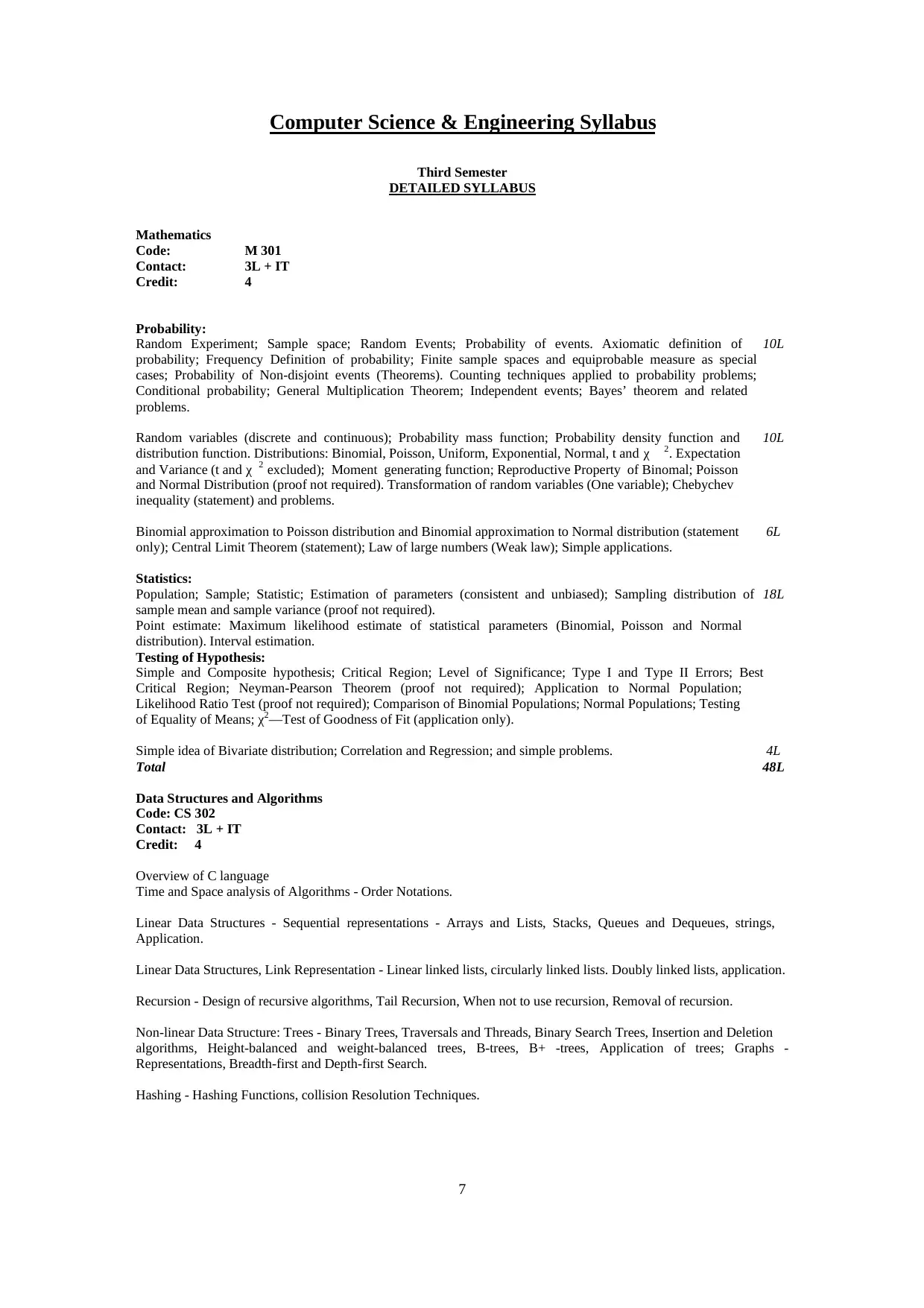
Computer Science & Engineering Syllabus
7
Third Semester
DETAILED SYLLABUS
Mathematics
Code: M 301
Contact: 3L + IT
Credit: 4
Probability:
Random Experiment; Sample space; Random Events; Probability of events. Axiomatic definition of
probability; Frequency Definition of probability; Finite sample spaces and equiprobable measure as special
cases; Probability of Non-disjoint events (Theorems). Counting techniques applied to probability problems;
Conditional probability; General Multiplication Theorem; Independent events; Bayes’ theorem and related
problems.
10L
Random variables (discrete and continuous); Probability mass function; Probability density function and
distribution function. Distributions: Binomial, Poisson, Uniform, Exponential, Normal, t and χ 2. Expectation
and Variance (t and χ 2 excluded); Moment generating function; Reproductive Property of Binomal; Poisson
and Normal Distribution (proof not required). Transformation of random variables (One variable); Chebychev
inequality (statement) and problems.
10L
Binomial approximation to Poisson distribution and Binomial approximation to Normal distribution (statement
only); Central Limit Theorem (statement); Law of large numbers (Weak law); Simple applications.
6L
Statistics:
Population; Sample; Statistic; Estimation of parameters (consistent and unbiased); Sampling distribution of
sample mean and sample variance (proof not required).
Point estimate: Maximum likelihood estimate of statistical parameters (Binomial, Poisson and Normal
distribution). Interval estimation.
Testing of Hypothesis:
Simple and Composite hypothesis; Critical Region; Level of Significance; Type I and Type II Errors; Best
Critical Region; Neyman-Pearson Theorem (proof not required); Application to Normal Population;
Likelihood Ratio Test (proof not required); Comparison of Binomial Populations; Normal Populations; Testing
of Equality of Means; χ2—Test of Goodness of Fit (application only).
18L
Simple idea of Bivariate distribution; Correlation and Regression; and simple problems. 4L
Total 48L
Data Structures and Algorithms
Code: CS 302
Contact: 3L + IT
Credit: 4
Overview of C language
Time and Space analysis of Algorithms - Order Notations.
Linear Data Structures - Sequential representations - Arrays and Lists, Stacks, Queues and Dequeues, strings,
Application.
Linear Data Structures, Link Representation - Linear linked lists, circularly linked lists. Doubly linked lists, application.
Recursion - Design of recursive algorithms, Tail Recursion, When not to use recursion, Removal of recursion.
Non-linear Data Structure: Trees - Binary Trees, Traversals and Threads, Binary Search Trees, Insertion and Deletion
algorithms, Height-balanced and weight-balanced trees, B-trees, B+ -trees, Application of trees; Graphs -
Representations, Breadth-first and Depth-first Search.
Hashing - Hashing Functions, collision Resolution Techniques.
7
Third Semester
DETAILED SYLLABUS
Mathematics
Code: M 301
Contact: 3L + IT
Credit: 4
Probability:
Random Experiment; Sample space; Random Events; Probability of events. Axiomatic definition of
probability; Frequency Definition of probability; Finite sample spaces and equiprobable measure as special
cases; Probability of Non-disjoint events (Theorems). Counting techniques applied to probability problems;
Conditional probability; General Multiplication Theorem; Independent events; Bayes’ theorem and related
problems.
10L
Random variables (discrete and continuous); Probability mass function; Probability density function and
distribution function. Distributions: Binomial, Poisson, Uniform, Exponential, Normal, t and χ 2. Expectation
and Variance (t and χ 2 excluded); Moment generating function; Reproductive Property of Binomal; Poisson
and Normal Distribution (proof not required). Transformation of random variables (One variable); Chebychev
inequality (statement) and problems.
10L
Binomial approximation to Poisson distribution and Binomial approximation to Normal distribution (statement
only); Central Limit Theorem (statement); Law of large numbers (Weak law); Simple applications.
6L
Statistics:
Population; Sample; Statistic; Estimation of parameters (consistent and unbiased); Sampling distribution of
sample mean and sample variance (proof not required).
Point estimate: Maximum likelihood estimate of statistical parameters (Binomial, Poisson and Normal
distribution). Interval estimation.
Testing of Hypothesis:
Simple and Composite hypothesis; Critical Region; Level of Significance; Type I and Type II Errors; Best
Critical Region; Neyman-Pearson Theorem (proof not required); Application to Normal Population;
Likelihood Ratio Test (proof not required); Comparison of Binomial Populations; Normal Populations; Testing
of Equality of Means; χ2—Test of Goodness of Fit (application only).
18L
Simple idea of Bivariate distribution; Correlation and Regression; and simple problems. 4L
Total 48L
Data Structures and Algorithms
Code: CS 302
Contact: 3L + IT
Credit: 4
Overview of C language
Time and Space analysis of Algorithms - Order Notations.
Linear Data Structures - Sequential representations - Arrays and Lists, Stacks, Queues and Dequeues, strings,
Application.
Linear Data Structures, Link Representation - Linear linked lists, circularly linked lists. Doubly linked lists, application.
Recursion - Design of recursive algorithms, Tail Recursion, When not to use recursion, Removal of recursion.
Non-linear Data Structure: Trees - Binary Trees, Traversals and Threads, Binary Search Trees, Insertion and Deletion
algorithms, Height-balanced and weight-balanced trees, B-trees, B+ -trees, Application of trees; Graphs -
Representations, Breadth-first and Depth-first Search.
Hashing - Hashing Functions, collision Resolution Techniques.
Paraphrase This Document
Need a fresh take? Get an instant paraphrase of this document with our AI Paraphraser
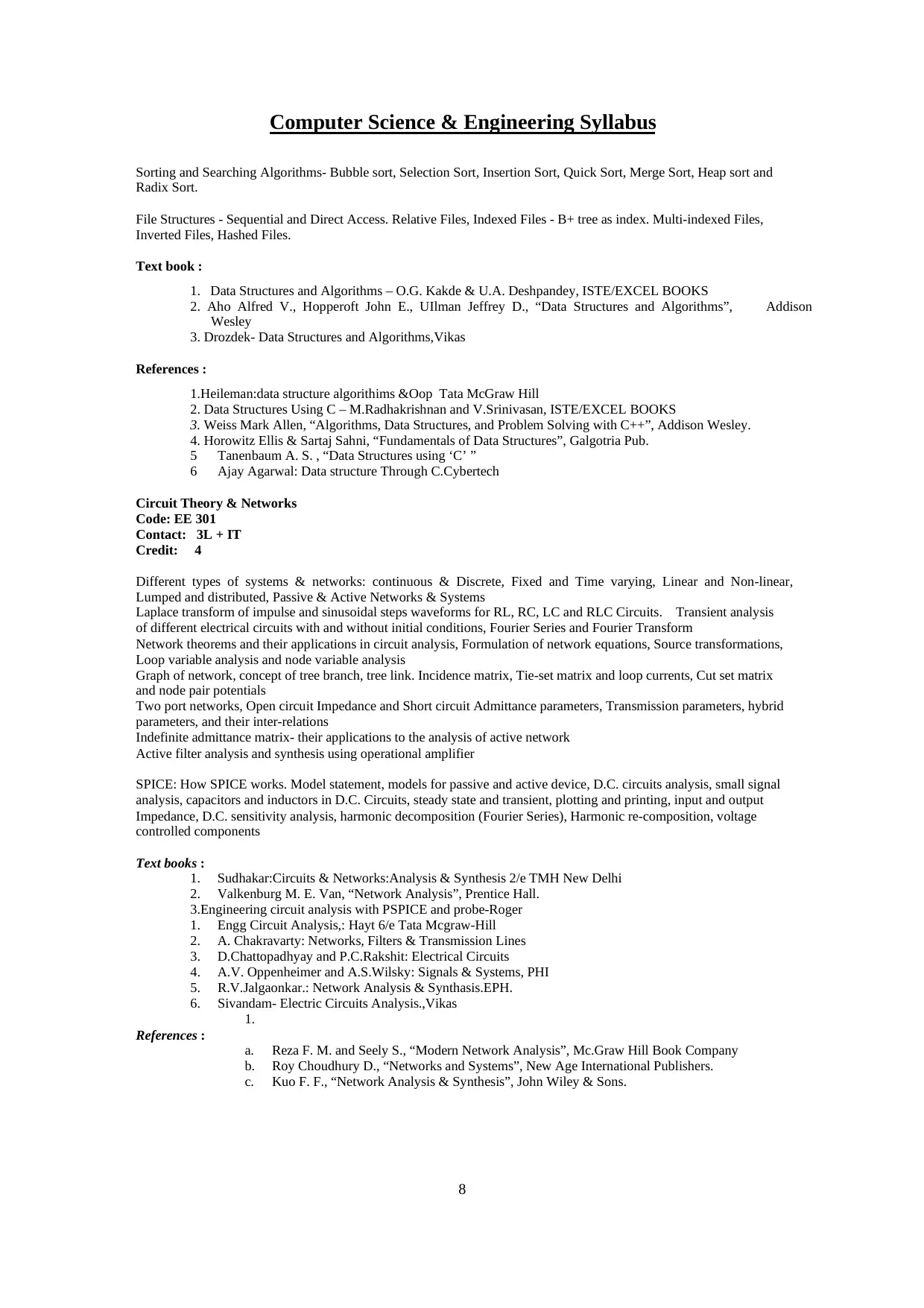
Computer Science & Engineering Syllabus
8
Sorting and Searching Algorithms- Bubble sort, Selection Sort, Insertion Sort, Quick Sort, Merge Sort, Heap sort and
Radix Sort.
File Structures - Sequential and Direct Access. Relative Files, Indexed Files - B+ tree as index. Multi-indexed Files,
Inverted Files, Hashed Files.
Text book :
1. Data Structures and Algorithms – O.G. Kakde & U.A. Deshpandey, ISTE/EXCEL BOOKS
2. Aho Alfred V., Hopperoft John E., UIlman Jeffrey D., “Data Structures and Algorithms”, Addison
Wesley
3. Drozdek- Data Structures and Algorithms,Vikas
References :
1.Heileman:data structure algorithims &Oop Tata McGraw Hill
2. Data Structures Using C – M.Radhakrishnan and V.Srinivasan, ISTE/EXCEL BOOKS
3. Weiss Mark Allen, “Algorithms, Data Structures, and Problem Solving with C++”, Addison Wesley.
4. Horowitz Ellis & Sartaj Sahni, “Fundamentals of Data Structures”, Galgotria Pub.
5 Tanenbaum A. S. , “Data Structures using ‘C’ ”
6 Ajay Agarwal: Data structure Through C.Cybertech
Circuit Theory & Networks
Code: EE 301
Contact: 3L + IT
Credit: 4
Different types of systems & networks: continuous & Discrete, Fixed and Time varying, Linear and Non-linear,
Lumped and distributed, Passive & Active Networks & Systems
Laplace transform of impulse and sinusoidal steps waveforms for RL, RC, LC and RLC Circuits. Transient analysis
of different electrical circuits with and without initial conditions, Fourier Series and Fourier Transform
Network theorems and their applications in circuit analysis, Formulation of network equations, Source transformations,
Loop variable analysis and node variable analysis
Graph of network, concept of tree branch, tree link. Incidence matrix, Tie-set matrix and loop currents, Cut set matrix
and node pair potentials
Two port networks, Open circuit Impedance and Short circuit Admittance parameters, Transmission parameters, hybrid
parameters, and their inter-relations
Indefinite admittance matrix- their applications to the analysis of active network
Active filter analysis and synthesis using operational amplifier
SPICE: How SPICE works. Model statement, models for passive and active device, D.C. circuits analysis, small signal
analysis, capacitors and inductors in D.C. Circuits, steady state and transient, plotting and printing, input and output
Impedance, D.C. sensitivity analysis, harmonic decomposition (Fourier Series), Harmonic re-composition, voltage
controlled components
Text books :
1. Sudhakar:Circuits & Networks:Analysis & Synthesis 2/e TMH New Delhi
2. Valkenburg M. E. Van, “Network Analysis”, Prentice Hall.
3.Engineering circuit analysis with PSPICE and probe-Roger
1. Engg Circuit Analysis,: Hayt 6/e Tata Mcgraw-Hill
2. A. Chakravarty: Networks, Filters & Transmission Lines
3. D.Chattopadhyay and P.C.Rakshit: Electrical Circuits
4. A.V. Oppenheimer and A.S.Wilsky: Signals & Systems, PHI
5. R.V.Jalgaonkar.: Network Analysis & Synthasis.EPH.
6. Sivandam- Electric Circuits Analysis.,Vikas
1.
References :
a. Reza F. M. and Seely S., “Modern Network Analysis”, Mc.Graw Hill Book Company
b. Roy Choudhury D., “Networks and Systems”, New Age International Publishers.
c. Kuo F. F., “Network Analysis & Synthesis”, John Wiley & Sons.
8
Sorting and Searching Algorithms- Bubble sort, Selection Sort, Insertion Sort, Quick Sort, Merge Sort, Heap sort and
Radix Sort.
File Structures - Sequential and Direct Access. Relative Files, Indexed Files - B+ tree as index. Multi-indexed Files,
Inverted Files, Hashed Files.
Text book :
1. Data Structures and Algorithms – O.G. Kakde & U.A. Deshpandey, ISTE/EXCEL BOOKS
2. Aho Alfred V., Hopperoft John E., UIlman Jeffrey D., “Data Structures and Algorithms”, Addison
Wesley
3. Drozdek- Data Structures and Algorithms,Vikas
References :
1.Heileman:data structure algorithims &Oop Tata McGraw Hill
2. Data Structures Using C – M.Radhakrishnan and V.Srinivasan, ISTE/EXCEL BOOKS
3. Weiss Mark Allen, “Algorithms, Data Structures, and Problem Solving with C++”, Addison Wesley.
4. Horowitz Ellis & Sartaj Sahni, “Fundamentals of Data Structures”, Galgotria Pub.
5 Tanenbaum A. S. , “Data Structures using ‘C’ ”
6 Ajay Agarwal: Data structure Through C.Cybertech
Circuit Theory & Networks
Code: EE 301
Contact: 3L + IT
Credit: 4
Different types of systems & networks: continuous & Discrete, Fixed and Time varying, Linear and Non-linear,
Lumped and distributed, Passive & Active Networks & Systems
Laplace transform of impulse and sinusoidal steps waveforms for RL, RC, LC and RLC Circuits. Transient analysis
of different electrical circuits with and without initial conditions, Fourier Series and Fourier Transform
Network theorems and their applications in circuit analysis, Formulation of network equations, Source transformations,
Loop variable analysis and node variable analysis
Graph of network, concept of tree branch, tree link. Incidence matrix, Tie-set matrix and loop currents, Cut set matrix
and node pair potentials
Two port networks, Open circuit Impedance and Short circuit Admittance parameters, Transmission parameters, hybrid
parameters, and their inter-relations
Indefinite admittance matrix- their applications to the analysis of active network
Active filter analysis and synthesis using operational amplifier
SPICE: How SPICE works. Model statement, models for passive and active device, D.C. circuits analysis, small signal
analysis, capacitors and inductors in D.C. Circuits, steady state and transient, plotting and printing, input and output
Impedance, D.C. sensitivity analysis, harmonic decomposition (Fourier Series), Harmonic re-composition, voltage
controlled components
Text books :
1. Sudhakar:Circuits & Networks:Analysis & Synthesis 2/e TMH New Delhi
2. Valkenburg M. E. Van, “Network Analysis”, Prentice Hall.
3.Engineering circuit analysis with PSPICE and probe-Roger
1. Engg Circuit Analysis,: Hayt 6/e Tata Mcgraw-Hill
2. A. Chakravarty: Networks, Filters & Transmission Lines
3. D.Chattopadhyay and P.C.Rakshit: Electrical Circuits
4. A.V. Oppenheimer and A.S.Wilsky: Signals & Systems, PHI
5. R.V.Jalgaonkar.: Network Analysis & Synthasis.EPH.
6. Sivandam- Electric Circuits Analysis.,Vikas
1.
References :
a. Reza F. M. and Seely S., “Modern Network Analysis”, Mc.Graw Hill Book Company
b. Roy Choudhury D., “Networks and Systems”, New Age International Publishers.
c. Kuo F. F., “Network Analysis & Synthesis”, John Wiley & Sons.
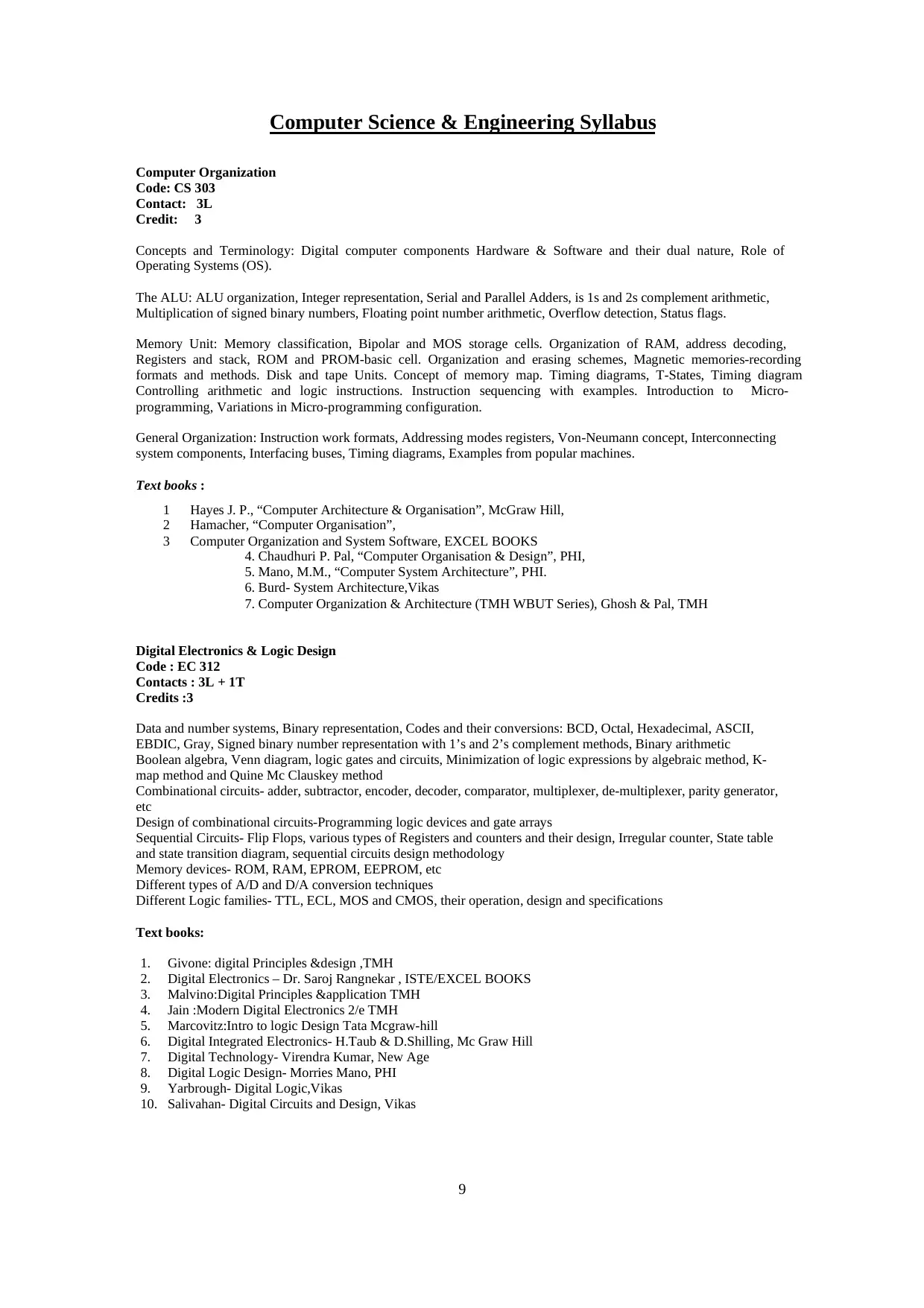
Computer Science & Engineering Syllabus
9
Computer Organization
Code: CS 303
Contact: 3L
Credit: 3
Concepts and Terminology: Digital computer components Hardware & Software and their dual nature, Role of
Operating Systems (OS).
The ALU: ALU organization, Integer representation, Serial and Parallel Adders, is 1s and 2s complement arithmetic,
Multiplication of signed binary numbers, Floating point number arithmetic, Overflow detection, Status flags.
Memory Unit: Memory classification, Bipolar and MOS storage cells. Organization of RAM, address decoding,
Registers and stack, ROM and PROM-basic cell. Organization and erasing schemes, Magnetic memories-recording
formats and methods. Disk and tape Units. Concept of memory map. Timing diagrams, T-States, Timing diagram
Controlling arithmetic and logic instructions. Instruction sequencing with examples. Introduction to Micro-
programming, Variations in Micro-programming configuration.
General Organization: Instruction work formats, Addressing modes registers, Von-Neumann concept, Interconnecting
system components, Interfacing buses, Timing diagrams, Examples from popular machines.
Text books :
1 Hayes J. P., “Computer Architecture & Organisation”, McGraw Hill,
2 Hamacher, “Computer Organisation”,
3 Computer Organization and System Software, EXCEL BOOKS
4. Chaudhuri P. Pal, “Computer Organisation & Design”, PHI,
5. Mano, M.M., “Computer System Architecture”, PHI.
6. Burd- System Architecture,Vikas
7. Computer Organization & Architecture (TMH WBUT Series), Ghosh & Pal, TMH
Digital Electronics & Logic Design
Code : EC 312
Contacts : 3L + 1T
Credits :3
Data and number systems, Binary representation, Codes and their conversions: BCD, Octal, Hexadecimal, ASCII,
EBDIC, Gray, Signed binary number representation with 1’s and 2’s complement methods, Binary arithmetic
Boolean algebra, Venn diagram, logic gates and circuits, Minimization of logic expressions by algebraic method, K-
map method and Quine Mc Clauskey method
Combinational circuits- adder, subtractor, encoder, decoder, comparator, multiplexer, de-multiplexer, parity generator,
etc
Design of combinational circuits-Programming logic devices and gate arrays
Sequential Circuits- Flip Flops, various types of Registers and counters and their design, Irregular counter, State table
and state transition diagram, sequential circuits design methodology
Memory devices- ROM, RAM, EPROM, EEPROM, etc
Different types of A/D and D/A conversion techniques
Different Logic families- TTL, ECL, MOS and CMOS, their operation, design and specifications
Text books:
1. Givone: digital Principles &design ,TMH
2. Digital Electronics – Dr. Saroj Rangnekar , ISTE/EXCEL BOOKS
3. Malvino:Digital Principles &application TMH
4. Jain :Modern Digital Electronics 2/e TMH
5. Marcovitz:Intro to logic Design Tata Mcgraw-hill
6. Digital Integrated Electronics- H.Taub & D.Shilling, Mc Graw Hill
7. Digital Technology- Virendra Kumar, New Age
8. Digital Logic Design- Morries Mano, PHI
9. Yarbrough- Digital Logic,Vikas
10. Salivahan- Digital Circuits and Design, Vikas
9
Computer Organization
Code: CS 303
Contact: 3L
Credit: 3
Concepts and Terminology: Digital computer components Hardware & Software and their dual nature, Role of
Operating Systems (OS).
The ALU: ALU organization, Integer representation, Serial and Parallel Adders, is 1s and 2s complement arithmetic,
Multiplication of signed binary numbers, Floating point number arithmetic, Overflow detection, Status flags.
Memory Unit: Memory classification, Bipolar and MOS storage cells. Organization of RAM, address decoding,
Registers and stack, ROM and PROM-basic cell. Organization and erasing schemes, Magnetic memories-recording
formats and methods. Disk and tape Units. Concept of memory map. Timing diagrams, T-States, Timing diagram
Controlling arithmetic and logic instructions. Instruction sequencing with examples. Introduction to Micro-
programming, Variations in Micro-programming configuration.
General Organization: Instruction work formats, Addressing modes registers, Von-Neumann concept, Interconnecting
system components, Interfacing buses, Timing diagrams, Examples from popular machines.
Text books :
1 Hayes J. P., “Computer Architecture & Organisation”, McGraw Hill,
2 Hamacher, “Computer Organisation”,
3 Computer Organization and System Software, EXCEL BOOKS
4. Chaudhuri P. Pal, “Computer Organisation & Design”, PHI,
5. Mano, M.M., “Computer System Architecture”, PHI.
6. Burd- System Architecture,Vikas
7. Computer Organization & Architecture (TMH WBUT Series), Ghosh & Pal, TMH
Digital Electronics & Logic Design
Code : EC 312
Contacts : 3L + 1T
Credits :3
Data and number systems, Binary representation, Codes and their conversions: BCD, Octal, Hexadecimal, ASCII,
EBDIC, Gray, Signed binary number representation with 1’s and 2’s complement methods, Binary arithmetic
Boolean algebra, Venn diagram, logic gates and circuits, Minimization of logic expressions by algebraic method, K-
map method and Quine Mc Clauskey method
Combinational circuits- adder, subtractor, encoder, decoder, comparator, multiplexer, de-multiplexer, parity generator,
etc
Design of combinational circuits-Programming logic devices and gate arrays
Sequential Circuits- Flip Flops, various types of Registers and counters and their design, Irregular counter, State table
and state transition diagram, sequential circuits design methodology
Memory devices- ROM, RAM, EPROM, EEPROM, etc
Different types of A/D and D/A conversion techniques
Different Logic families- TTL, ECL, MOS and CMOS, their operation, design and specifications
Text books:
1. Givone: digital Principles &design ,TMH
2. Digital Electronics – Dr. Saroj Rangnekar , ISTE/EXCEL BOOKS
3. Malvino:Digital Principles &application TMH
4. Jain :Modern Digital Electronics 2/e TMH
5. Marcovitz:Intro to logic Design Tata Mcgraw-hill
6. Digital Integrated Electronics- H.Taub & D.Shilling, Mc Graw Hill
7. Digital Technology- Virendra Kumar, New Age
8. Digital Logic Design- Morries Mano, PHI
9. Yarbrough- Digital Logic,Vikas
10. Salivahan- Digital Circuits and Design, Vikas
⊘ This is a preview!⊘
Do you want full access?
Subscribe today to unlock all pages.

Trusted by 1+ million students worldwide
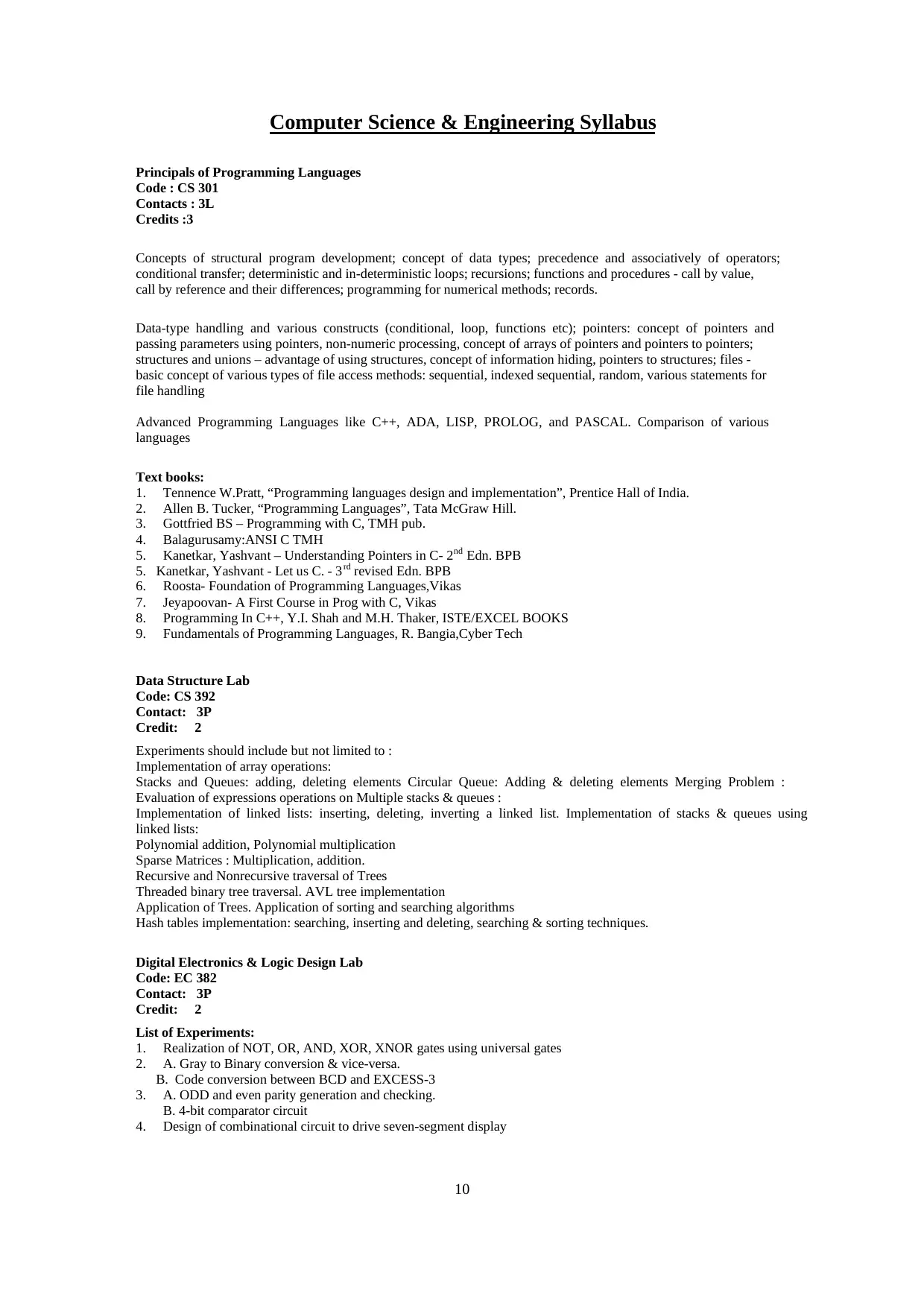
Computer Science & Engineering Syllabus
10
Principals of Programming Languages
Code : CS 301
Contacts : 3L
Credits :3
Concepts of structural program development; concept of data types; precedence and associatively of operators;
conditional transfer; deterministic and in-deterministic loops; recursions; functions and procedures - call by value,
call by reference and their differences; programming for numerical methods; records.
Data-type handling and various constructs (conditional, loop, functions etc); pointers: concept of pointers and
passing parameters using pointers, non-numeric processing, concept of arrays of pointers and pointers to pointers;
structures and unions – advantage of using structures, concept of information hiding, pointers to structures; files -
basic concept of various types of file access methods: sequential, indexed sequential, random, various statements for
file handling
Advanced Programming Languages like C++, ADA, LISP, PROLOG, and PASCAL. Comparison of various
languages
Text books:
1. Tennence W.Pratt, “Programming languages design and implementation”, Prentice Hall of India.
2. Allen B. Tucker, “Programming Languages”, Tata McGraw Hill.
3. Gottfried BS – Programming with C, TMH pub.
4. Balagurusamy:ANSI C TMH
5. Kanetkar, Yashvant – Understanding Pointers in C- 2nd Edn. BPB
5. Kanetkar, Yashvant - Let us C. - 3rd revised Edn. BPB
6. Roosta- Foundation of Programming Languages,Vikas
7. Jeyapoovan- A First Course in Prog with C, Vikas
8. Programming In C++, Y.I. Shah and M.H. Thaker, ISTE/EXCEL BOOKS
9. Fundamentals of Programming Languages, R. Bangia,Cyber Tech
Data Structure Lab
Code: CS 392
Contact: 3P
Credit: 2
Experiments should include but not limited to :
Implementation of array operations:
Stacks and Queues: adding, deleting elements Circular Queue: Adding & deleting elements Merging Problem :
Evaluation of expressions operations on Multiple stacks & queues :
Implementation of linked lists: inserting, deleting, inverting a linked list. Implementation of stacks & queues using
linked lists:
Polynomial addition, Polynomial multiplication
Sparse Matrices : Multiplication, addition.
Recursive and Nonrecursive traversal of Trees
Threaded binary tree traversal. AVL tree implementation
Application of Trees. Application of sorting and searching algorithms
Hash tables implementation: searching, inserting and deleting, searching & sorting techniques.
Digital Electronics & Logic Design Lab
Code: EC 382
Contact: 3P
Credit: 2
List of Experiments:
1. Realization of NOT, OR, AND, XOR, XNOR gates using universal gates
2. A. Gray to Binary conversion & vice-versa.
B. Code conversion between BCD and EXCESS-3
3. A. ODD and even parity generation and checking.
B. 4-bit comparator circuit
4. Design of combinational circuit to drive seven-segment display
10
Principals of Programming Languages
Code : CS 301
Contacts : 3L
Credits :3
Concepts of structural program development; concept of data types; precedence and associatively of operators;
conditional transfer; deterministic and in-deterministic loops; recursions; functions and procedures - call by value,
call by reference and their differences; programming for numerical methods; records.
Data-type handling and various constructs (conditional, loop, functions etc); pointers: concept of pointers and
passing parameters using pointers, non-numeric processing, concept of arrays of pointers and pointers to pointers;
structures and unions – advantage of using structures, concept of information hiding, pointers to structures; files -
basic concept of various types of file access methods: sequential, indexed sequential, random, various statements for
file handling
Advanced Programming Languages like C++, ADA, LISP, PROLOG, and PASCAL. Comparison of various
languages
Text books:
1. Tennence W.Pratt, “Programming languages design and implementation”, Prentice Hall of India.
2. Allen B. Tucker, “Programming Languages”, Tata McGraw Hill.
3. Gottfried BS – Programming with C, TMH pub.
4. Balagurusamy:ANSI C TMH
5. Kanetkar, Yashvant – Understanding Pointers in C- 2nd Edn. BPB
5. Kanetkar, Yashvant - Let us C. - 3rd revised Edn. BPB
6. Roosta- Foundation of Programming Languages,Vikas
7. Jeyapoovan- A First Course in Prog with C, Vikas
8. Programming In C++, Y.I. Shah and M.H. Thaker, ISTE/EXCEL BOOKS
9. Fundamentals of Programming Languages, R. Bangia,Cyber Tech
Data Structure Lab
Code: CS 392
Contact: 3P
Credit: 2
Experiments should include but not limited to :
Implementation of array operations:
Stacks and Queues: adding, deleting elements Circular Queue: Adding & deleting elements Merging Problem :
Evaluation of expressions operations on Multiple stacks & queues :
Implementation of linked lists: inserting, deleting, inverting a linked list. Implementation of stacks & queues using
linked lists:
Polynomial addition, Polynomial multiplication
Sparse Matrices : Multiplication, addition.
Recursive and Nonrecursive traversal of Trees
Threaded binary tree traversal. AVL tree implementation
Application of Trees. Application of sorting and searching algorithms
Hash tables implementation: searching, inserting and deleting, searching & sorting techniques.
Digital Electronics & Logic Design Lab
Code: EC 382
Contact: 3P
Credit: 2
List of Experiments:
1. Realization of NOT, OR, AND, XOR, XNOR gates using universal gates
2. A. Gray to Binary conversion & vice-versa.
B. Code conversion between BCD and EXCESS-3
3. A. ODD and even parity generation and checking.
B. 4-bit comparator circuit
4. Design of combinational circuit to drive seven-segment display
Paraphrase This Document
Need a fresh take? Get an instant paraphrase of this document with our AI Paraphraser
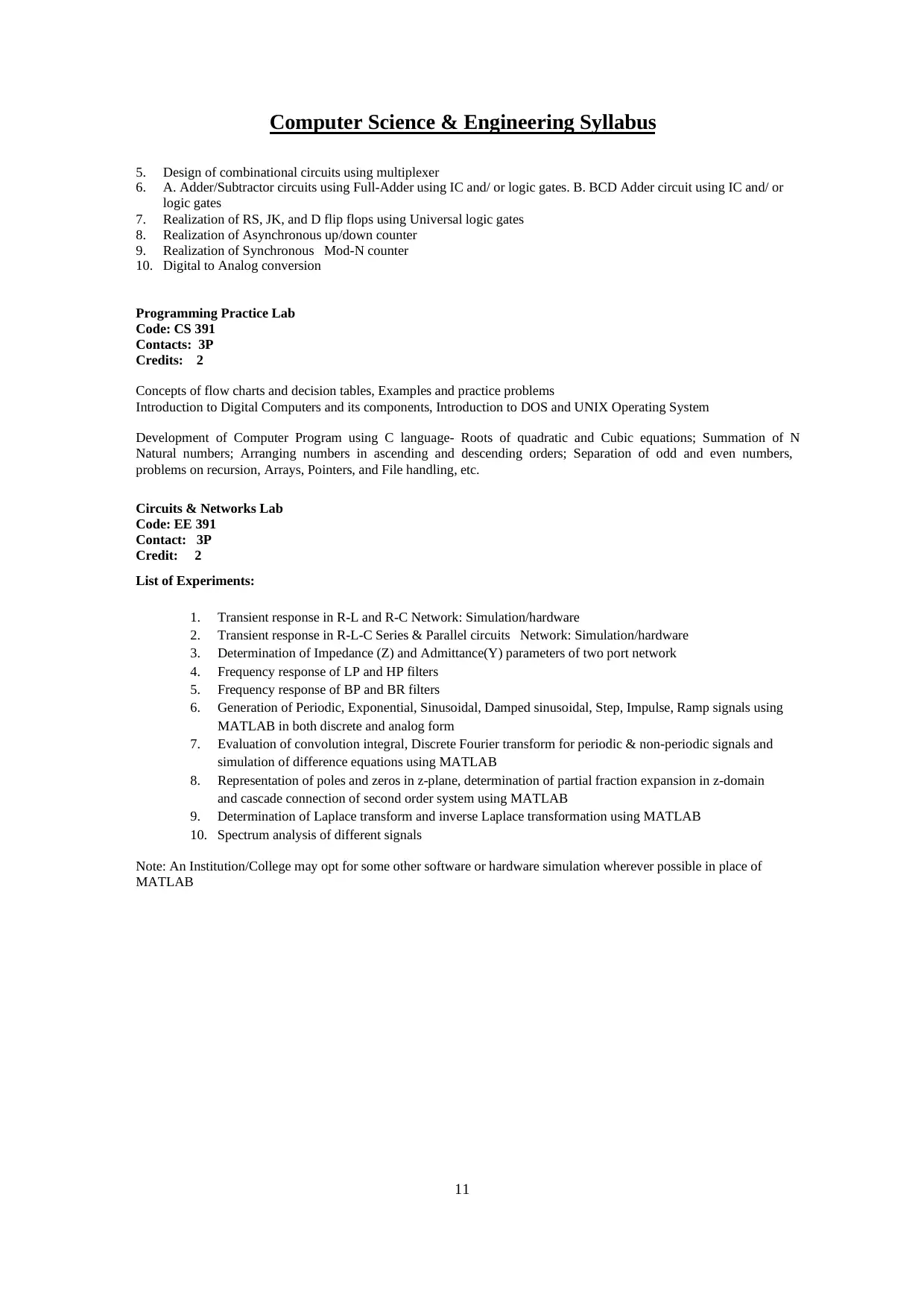
Computer Science & Engineering Syllabus
11
5. Design of combinational circuits using multiplexer
6. A. Adder/Subtractor circuits using Full-Adder using IC and/ or logic gates. B. BCD Adder circuit using IC and/ or
logic gates
7. Realization of RS, JK, and D flip flops using Universal logic gates
8. Realization of Asynchronous up/down counter
9. Realization of Synchronous Mod-N counter
10. Digital to Analog conversion
Programming Practice Lab
Code: CS 391
Contacts: 3P
Credits: 2
Concepts of flow charts and decision tables, Examples and practice problems
Introduction to Digital Computers and its components, Introduction to DOS and UNIX Operating System
Development of Computer Program using C language- Roots of quadratic and Cubic equations; Summation of N
Natural numbers; Arranging numbers in ascending and descending orders; Separation of odd and even numbers,
problems on recursion, Arrays, Pointers, and File handling, etc.
Circuits & Networks Lab
Code: EE 391
Contact: 3P
Credit: 2
List of Experiments:
1. Transient response in R-L and R-C Network: Simulation/hardware
2. Transient response in R-L-C Series & Parallel circuits Network: Simulation/hardware
3. Determination of Impedance (Z) and Admittance(Y) parameters of two port network
4. Frequency response of LP and HP filters
5. Frequency response of BP and BR filters
6. Generation of Periodic, Exponential, Sinusoidal, Damped sinusoidal, Step, Impulse, Ramp signals using
MATLAB in both discrete and analog form
7. Evaluation of convolution integral, Discrete Fourier transform for periodic & non-periodic signals and
simulation of difference equations using MATLAB
8. Representation of poles and zeros in z-plane, determination of partial fraction expansion in z-domain
and cascade connection of second order system using MATLAB
9. Determination of Laplace transform and inverse Laplace transformation using MATLAB
10. Spectrum analysis of different signals
Note: An Institution/College may opt for some other software or hardware simulation wherever possible in place of
MATLAB
11
5. Design of combinational circuits using multiplexer
6. A. Adder/Subtractor circuits using Full-Adder using IC and/ or logic gates. B. BCD Adder circuit using IC and/ or
logic gates
7. Realization of RS, JK, and D flip flops using Universal logic gates
8. Realization of Asynchronous up/down counter
9. Realization of Synchronous Mod-N counter
10. Digital to Analog conversion
Programming Practice Lab
Code: CS 391
Contacts: 3P
Credits: 2
Concepts of flow charts and decision tables, Examples and practice problems
Introduction to Digital Computers and its components, Introduction to DOS and UNIX Operating System
Development of Computer Program using C language- Roots of quadratic and Cubic equations; Summation of N
Natural numbers; Arranging numbers in ascending and descending orders; Separation of odd and even numbers,
problems on recursion, Arrays, Pointers, and File handling, etc.
Circuits & Networks Lab
Code: EE 391
Contact: 3P
Credit: 2
List of Experiments:
1. Transient response in R-L and R-C Network: Simulation/hardware
2. Transient response in R-L-C Series & Parallel circuits Network: Simulation/hardware
3. Determination of Impedance (Z) and Admittance(Y) parameters of two port network
4. Frequency response of LP and HP filters
5. Frequency response of BP and BR filters
6. Generation of Periodic, Exponential, Sinusoidal, Damped sinusoidal, Step, Impulse, Ramp signals using
MATLAB in both discrete and analog form
7. Evaluation of convolution integral, Discrete Fourier transform for periodic & non-periodic signals and
simulation of difference equations using MATLAB
8. Representation of poles and zeros in z-plane, determination of partial fraction expansion in z-domain
and cascade connection of second order system using MATLAB
9. Determination of Laplace transform and inverse Laplace transformation using MATLAB
10. Spectrum analysis of different signals
Note: An Institution/College may opt for some other software or hardware simulation wherever possible in place of
MATLAB
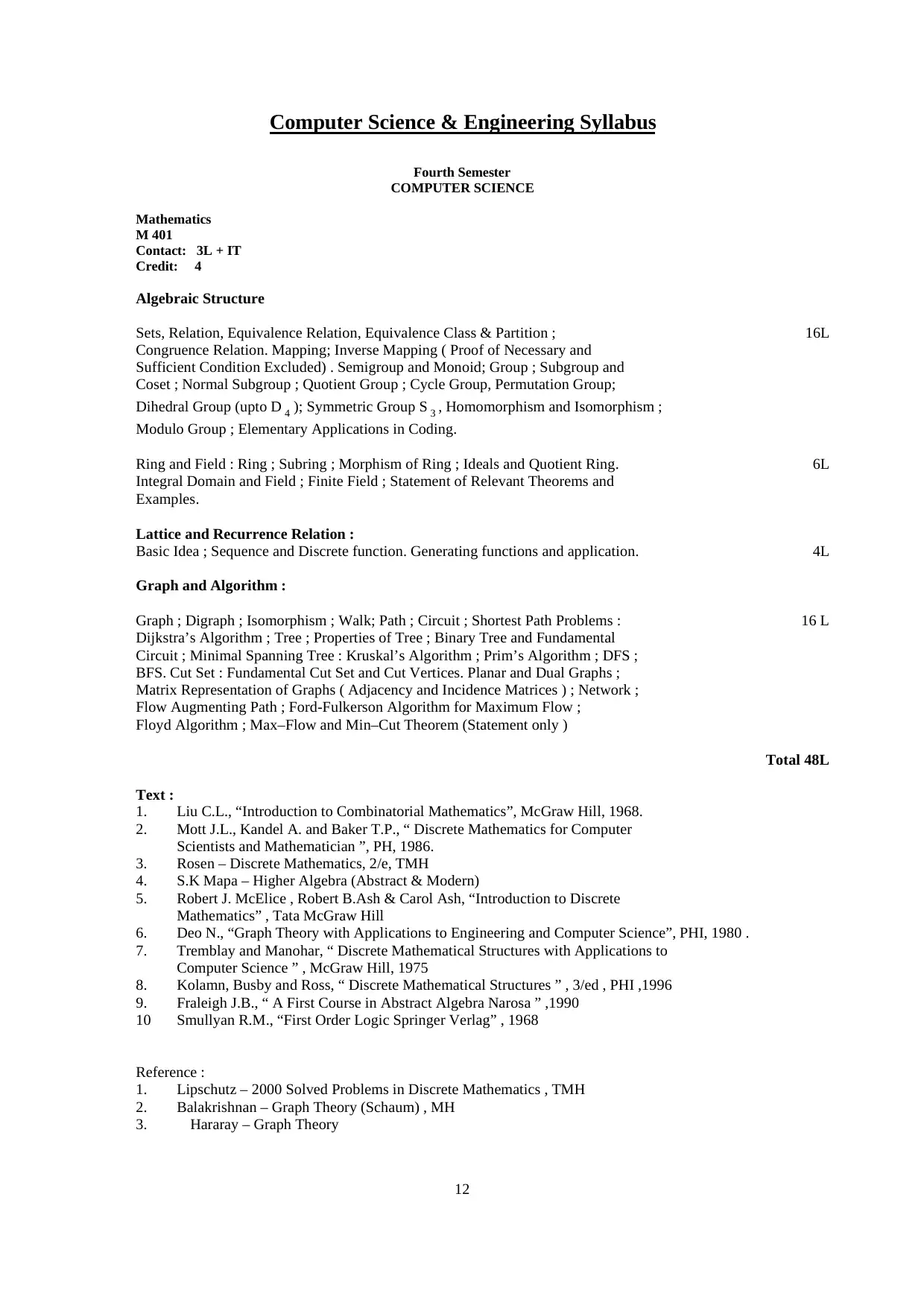
Computer Science & Engineering Syllabus
12
Fourth Semester
COMPUTER SCIENCE
Mathematics
M 401
Contact: 3L + IT
Credit: 4
Algebraic Structure
Sets, Relation, Equivalence Relation, Equivalence Class & Partition ; 16L
Congruence Relation. Mapping; Inverse Mapping ( Proof of Necessary and
Sufficient Condition Excluded) . Semigroup and Monoid; Group ; Subgroup and
Coset ; Normal Subgroup ; Quotient Group ; Cycle Group, Permutation Group;
Dihedral Group (upto D 4 ); Symmetric Group S 3 , Homomorphism and Isomorphism ;
Modulo Group ; Elementary Applications in Coding.
Ring and Field : Ring ; Subring ; Morphism of Ring ; Ideals and Quotient Ring. 6L
Integral Domain and Field ; Finite Field ; Statement of Relevant Theorems and
Examples.
Lattice and Recurrence Relation :
Basic Idea ; Sequence and Discrete function. Generating functions and application. 4L
Graph and Algorithm :
Graph ; Digraph ; Isomorphism ; Walk; Path ; Circuit ; Shortest Path Problems : 16 L
Dijkstra’s Algorithm ; Tree ; Properties of Tree ; Binary Tree and Fundamental
Circuit ; Minimal Spanning Tree : Kruskal’s Algorithm ; Prim’s Algorithm ; DFS ;
BFS. Cut Set : Fundamental Cut Set and Cut Vertices. Planar and Dual Graphs ;
Matrix Representation of Graphs ( Adjacency and Incidence Matrices ) ; Network ;
Flow Augmenting Path ; Ford-Fulkerson Algorithm for Maximum Flow ;
Floyd Algorithm ; Max–Flow and Min–Cut Theorem (Statement only )
Total 48L
Text :
1. Liu C.L., “Introduction to Combinatorial Mathematics”, McGraw Hill, 1968.
2. Mott J.L., Kandel A. and Baker T.P., “ Discrete Mathematics for Computer
Scientists and Mathematician ”, PH, 1986.
3. Rosen – Discrete Mathematics, 2/e, TMH
4. S.K Mapa – Higher Algebra (Abstract & Modern)
5. Robert J. McElice , Robert B.Ash & Carol Ash, “Introduction to Discrete
Mathematics” , Tata McGraw Hill
6. Deo N., “Graph Theory with Applications to Engineering and Computer Science”, PHI, 1980 .
7. Tremblay and Manohar, “ Discrete Mathematical Structures with Applications to
Computer Science ” , McGraw Hill, 1975
8. Kolamn, Busby and Ross, “ Discrete Mathematical Structures ” , 3/ed , PHI ,1996
9. Fraleigh J.B., “ A First Course in Abstract Algebra Narosa ” ,1990
10 Smullyan R.M., “First Order Logic Springer Verlag” , 1968
Reference :
1. Lipschutz – 2000 Solved Problems in Discrete Mathematics , TMH
2. Balakrishnan – Graph Theory (Schaum) , MH
3. Hararay – Graph Theory
12
Fourth Semester
COMPUTER SCIENCE
Mathematics
M 401
Contact: 3L + IT
Credit: 4
Algebraic Structure
Sets, Relation, Equivalence Relation, Equivalence Class & Partition ; 16L
Congruence Relation. Mapping; Inverse Mapping ( Proof of Necessary and
Sufficient Condition Excluded) . Semigroup and Monoid; Group ; Subgroup and
Coset ; Normal Subgroup ; Quotient Group ; Cycle Group, Permutation Group;
Dihedral Group (upto D 4 ); Symmetric Group S 3 , Homomorphism and Isomorphism ;
Modulo Group ; Elementary Applications in Coding.
Ring and Field : Ring ; Subring ; Morphism of Ring ; Ideals and Quotient Ring. 6L
Integral Domain and Field ; Finite Field ; Statement of Relevant Theorems and
Examples.
Lattice and Recurrence Relation :
Basic Idea ; Sequence and Discrete function. Generating functions and application. 4L
Graph and Algorithm :
Graph ; Digraph ; Isomorphism ; Walk; Path ; Circuit ; Shortest Path Problems : 16 L
Dijkstra’s Algorithm ; Tree ; Properties of Tree ; Binary Tree and Fundamental
Circuit ; Minimal Spanning Tree : Kruskal’s Algorithm ; Prim’s Algorithm ; DFS ;
BFS. Cut Set : Fundamental Cut Set and Cut Vertices. Planar and Dual Graphs ;
Matrix Representation of Graphs ( Adjacency and Incidence Matrices ) ; Network ;
Flow Augmenting Path ; Ford-Fulkerson Algorithm for Maximum Flow ;
Floyd Algorithm ; Max–Flow and Min–Cut Theorem (Statement only )
Total 48L
Text :
1. Liu C.L., “Introduction to Combinatorial Mathematics”, McGraw Hill, 1968.
2. Mott J.L., Kandel A. and Baker T.P., “ Discrete Mathematics for Computer
Scientists and Mathematician ”, PH, 1986.
3. Rosen – Discrete Mathematics, 2/e, TMH
4. S.K Mapa – Higher Algebra (Abstract & Modern)
5. Robert J. McElice , Robert B.Ash & Carol Ash, “Introduction to Discrete
Mathematics” , Tata McGraw Hill
6. Deo N., “Graph Theory with Applications to Engineering and Computer Science”, PHI, 1980 .
7. Tremblay and Manohar, “ Discrete Mathematical Structures with Applications to
Computer Science ” , McGraw Hill, 1975
8. Kolamn, Busby and Ross, “ Discrete Mathematical Structures ” , 3/ed , PHI ,1996
9. Fraleigh J.B., “ A First Course in Abstract Algebra Narosa ” ,1990
10 Smullyan R.M., “First Order Logic Springer Verlag” , 1968
Reference :
1. Lipschutz – 2000 Solved Problems in Discrete Mathematics , TMH
2. Balakrishnan – Graph Theory (Schaum) , MH
3. Hararay – Graph Theory
⊘ This is a preview!⊘
Do you want full access?
Subscribe today to unlock all pages.

Trusted by 1+ million students worldwide
1 out of 49
Your All-in-One AI-Powered Toolkit for Academic Success.
+13062052269
info@desklib.com
Available 24*7 on WhatsApp / Email
![[object Object]](/_next/static/media/star-bottom.7253800d.svg)
Unlock your academic potential
Copyright © 2020–2025 A2Z Services. All Rights Reserved. Developed and managed by ZUCOL.


